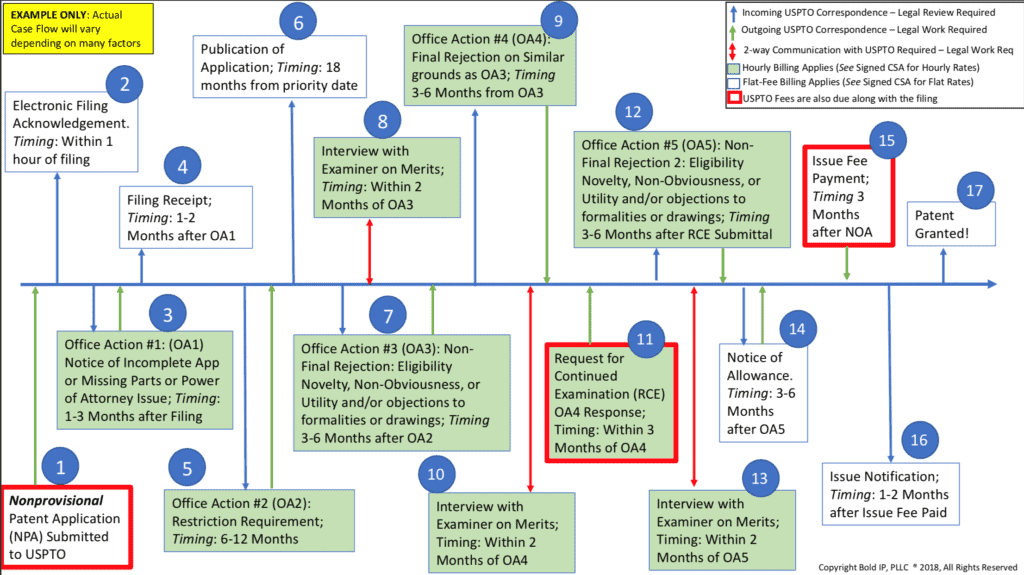Yes, as many legal answers begin, “it depends”…
…But, our clients and I almost always agree it takes WAY TOO LONG!
Don’t despair, there are a lot of things that you, the inventor, and us as your Patent Attorney can do to speed this process up and make things as efficient as possible while the case is pending at the United States Patent and Trademark Office (USPTO).
In this article, I’ll help make sure to answer this question with as little fluff and frills as possible, but also while delivering the details you need to really understand how long it will take so you and your business can make plans accordingly.
For your visual learners make sure to check out the video below! Enjoy!
Key Timing Considerations
There are many different types of patent applications. I discuss the different types (Design, Utility, Provisional, and Nonprovisional) in a separate article that you should have a good understanding of before you read this one!
You can also check out our website, which gives a great, easy to follow breakdown of the different types of patents.

Each type of application has different requirements, thus there are important timing considerations for each when it comes to attorney-client time, and processing time at the USPTO.
1.Provisionals
- Only provide you a filing date, and the opportunity to later file a nonprovisional application which will be able to claim priority to it. The timing here is a maximum of 1 year.
- If you file a provisional patent application, that means you are adding up to a whole YEAR to the overall timeline (this can be a good thing, but just know it will impact and delay the overall time before your rights grant)
- Provisional applications are an important consideration if there are any concerns that you may have disclosed your invention to the public, and you want to make sure you do not run afoul of any statutory bars.
2. Nonprovisionals
- Are the main type of application for utility patent applications and can take upwards of 4+ years to be examined, prosecuted and finally allowed through to issuance.
- When you file a nonprovisional patent application, there are petitions to make an application special (see below) for many reasons such as age, or health that can expedite the process.
- If you also file internationally (Patent Cooperation Treaty (PCT) or other national phase) it can impact your overall scope of rights because your application will be co-pending in several countries at once. This requires a careful approach.
- There are a few programs to expedite your patent application (discussed below) which are paid for (Track 1, Prioritized Examination, etc.)
3. Plant
- Plant patents are like utility nonprovisional patents, but tend not to take nearly as long – usually more than 2 years in pendency.
- Most programs that are available for Utility patent nonprovisional applications, also applies for Plant patent applications.
4. Design Patents
- Can take a while, but usually not longer than 2 years.
Technology Dependent
The amount of time a patent takes to get through the process is dependent in part upon the type of technology being sought for patent protection.
Some areas of technology take longer than others, largely because it is an area where there is a lot of innovation happening and therefore a lot of references and prior art to sift through.
An example would be high-tech inventions related to novel business methods using a mobile device over the internet (see example flow chart below for actual patent).
There are millions of possible parallel filings or references and they are all within the past 5-10 years, so there’s a lot of work to do to confirm that the invention being proposed is actually novel and nonobvious over the prior art.
In the below flow diagram showing the various steps, you can see the claims relate to an expansive array of activities that span wide swaths of current day e-commerce from Risk Management, to Online web crawlers, to Data storage and transmittal, etc.

On the other hand, a more mechanical device or apparatus that doesn’t have any moving parts could have a much easier time, because the prior art is well known, and likely existed years ago with very few recent references in the current day.
Here is an example of a classic patent for a simple mechanical device.
You can see that it is a shovel!
It does have a moving part (the handle), but you can see that there really is a finite and definite nature to this invention, and the work load required to figure out what prior art references should be used will be much less expansive than the business method shown above.
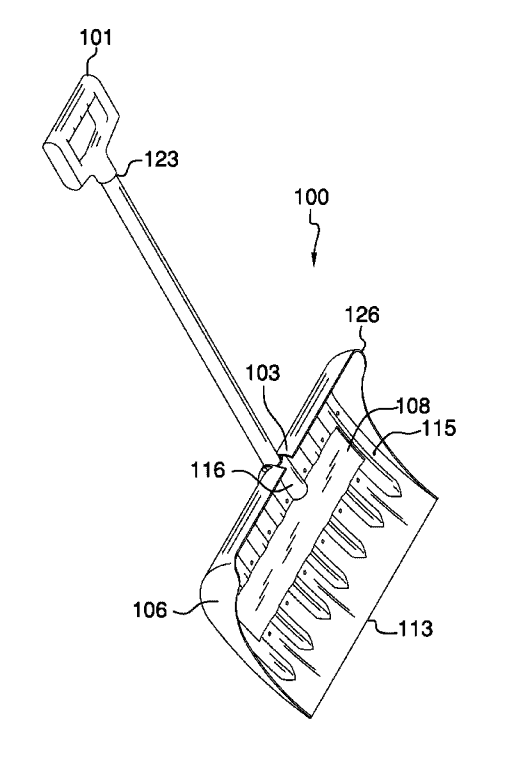
You’ll see below in the “Statistics” section, that there are vastly different prosecution times for different “art units”.
Art units are groups of examiners that specialize within a specific area of innovation and that’s the only kind of invention they review, conduct searches for, and examine.
Applicant Size
There are a few things about the applicant that can speed up or slow down prosecution.
Size matters…at least when it comes to cost!
My thought here is that the higher the cost to file, prosecute, and maintain a patent right – companies may be less inclined to start the process or may want to delay moving ahead until better financial times.
There are three types of sizes at the USPTO: Regular, Small, and Micro – where Regular pays the most and Micro pays the least.
The patent office makes a fair assumption that larger companies can afford to pay higher fees, and they want to allow the small or micro entities a more fair opportunity to protect their inventions by offering a lower fee.
A regular sized company with more than 500 employees has to pay full price throughout patent prosecution. While it may not mean anything right away, these costs add up and can cause some companies to reconsider whether they will proceed with protection.
Below is a current summary of USPTO filing costs as well as a chart on current fees that must be paid after the patent is issued to maintain it:


So, you can see the Small Entity fee is 50% of the cost of the regular entity, and the micro is 25% of the cost of the regular entity fee. Pretty substantial!
Applicant’s Age & Health
I love this one… The USPTO will put inventors that are over the age of 65 or that are in ill health to the front of the line when it comes to prosecution.
It’s incredibly fair. The system is set up to attempt to reward inventors and to make it such that they get adequate time to enjoy the fruits of their labor and enjoy their rights during their lifetime.

Source: 23 – Make special – age and health
A very simple form called a Petition to Make Special based on Age can be filed with evidence of birth date and photo ID, and a practitioner’s signature – and the overall pendency can be reduced by several months if not over a year!
A second form to Petition to Make Special based on health issue is just as important. If there is a substantial risk to the applicant’s life such that they may not be available (alive) during the course of the application should it take its normal course, it will be expedited.
Timing Considerations During Patent Process
There are 3 areas to consider for the timing process. Pre-filing, applications, and prosecution.
1. Pre-Filing (0-12 months)
I have 0 as a lower limit, because, in reality, research is not required. However, the less research done, the higher the risk that the patent application will be rejected by the examiner or that the claims will not be at the right scope. Research and Legal Analysis up front (in my opinion) required for a successful patent.Patent Research is critical in this stage and because there is really no end to the amount of research you can do, at some point, you’ve got to make that Bold step, and file your application. Here are the major areas that should be considered pre-filing:
- Subject Matter Eligibility Analysis: This initial stage answers the question, “Do I have a protectable invention?” This is quite simple for tangible inventions, but can be more difficult for computer-implemented inventions. Very extensive description on USPTO site here [0-7 Days]
- Statutory Bar Analysis: This should be conducted to make certain that there are no statutory bars that could later invalidate your patent rights. The two primary bars to patenting are 1-year public disclosure rule and 1-year sale/offer for sale bar. [0-30 Days]
- Inventorship Inquiry: This research is to confirm or deny any potential co-inventors. For most situations, this is straightforward, but for larger companies where multiple inventors had a hand in the conception, time should be taken to confirm this. There can also be some question when an inventor hires a contract designer or porotype/machinist to help bring their invention to life [0-30 Days]
- Ownership Inquiry: The research here can be more intense when the invention being sought for protection was invented while on the job, and the inventor is seeking independent ownership. The inquiry will deepen when employment contracts are debatable employee and employer disagree on conditions. [0-90 Days]
- Patentability: This is the BIGGEST question. After you’ve passed through the above wickets, the most amount of effort should be spent doing a world-wide patent search and legal opinion is critical. This research will confirm whether your invention is patentable and has enough novelty and is a nonobvious variant of the current publications in the industry. [30-90 Days]
- Marketability: Right behind patentability, assessing the market readiness for your product is second most important research to conduct prior to filing a patent application. You can have the most novel and unbelievable invention, but if there is no conceivable way to bring it to market and make money – it shouldn’t be patented. It is measuring BOTH patentability and marketability to really be able to stand back and assess whether there will be patent success.
2. Applications (30-90 Days)
As discussed above, the varying types of patent applications can have an impact on how long the overall process will take to get a patent.The estimate above of 30-120 Days is how long it will take your Patent Attorney to draft your patent application. Now, to more fully appreciate the details of how to file a patent application – see our blog here.
3. Prosecution (3-48 Months)
Yes, there is a huge range here. The below chart will outline a more typical utility patent application and the steps that are involved with potential fees.The reason for the range is because the simplest design application with the expedite fees paid and a petition to make special could all be filed together and be done in a matter of a few months. The large majority of applications take longer than 2 years.
Ways to Expedite the Process
The patent office has conceived of a few ways to speed up the process and in most ways, it costs extra money!
Below are the primary ways to expedite the patent process:
- “Track I” – See more at the USPTO website here.
- You can see below, a current statistic from the USPTO site, showing that a final office action (grant or rejection) is reached within 7 Months!
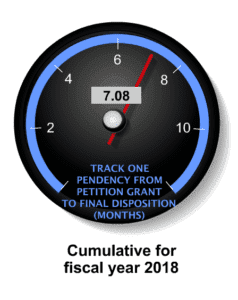
- You can see below, a current statistic from the USPTO site, showing that a final office action (grant or rejection) is reached within 7 Months!
- Petitions to Make Special Based on
- Age
- Health
- Technology (Environmental, Energy Savings, or National Security Improvement)
Here is a clip from 37 C.F.R. 1.102
The Statistics
I could spit-ball numbers based on specific client scenarios I’ve seen first-hand, but I think it’s better to provide you the aggregate stats over time for all applications that have been filed.
I don’t want to brag, but Bold Patents consistently outperforms these average numbers. We strive for perfection in improving our communicating with clients, examiners, and to understand the process better than anyone else.
Here are some general rules of thumb based on statistics from the USPTO (this is a great site by the way)!
So, as of the publication date of this blog, the USPTO publishes top-level stats on key indices on the “Data Visualization Center” website – here are the current numbers:
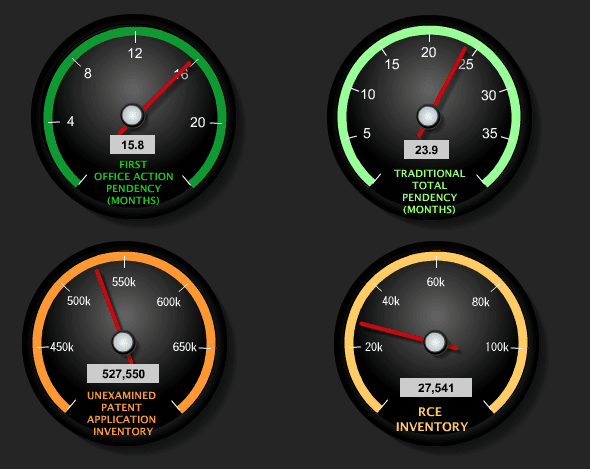
The upper left shows that for Non-Track I (expedited) examinations, it takes on average nearly 16 months (1 year and 4 months) to hear back from the USPTO after submittal. And over 24 months until there is a final disposition.
Now, there is some reason as to why it takes that long – you can see there are over 500,000 pending patent applications at the USPTO – so it’s no small task after all.
Just to show you an example of the great data that’s available, to show you how the patent office is slowly improving in clearing their backlog of inventions – albeit slowly…
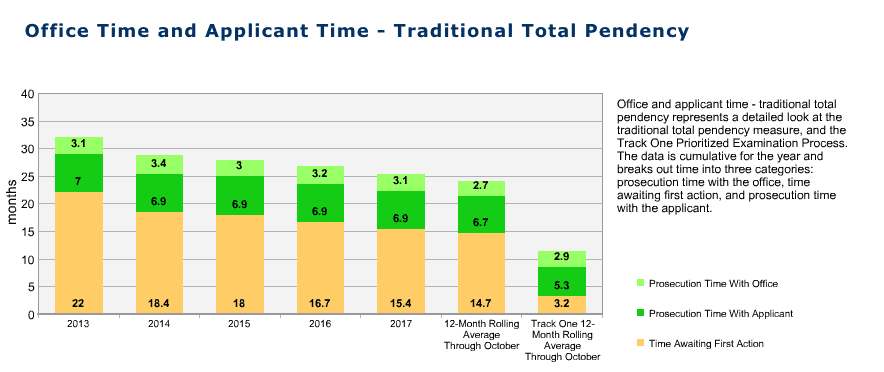
Looking up specific examiners can be very interesting – once you have your patent application assigned to an examiner, you can see the statistics for that specific examiner to put a strategy together.
Use Examiner Ninja to find out some awesome information about your examiner.
Here’s an example examiner James G. Smith:
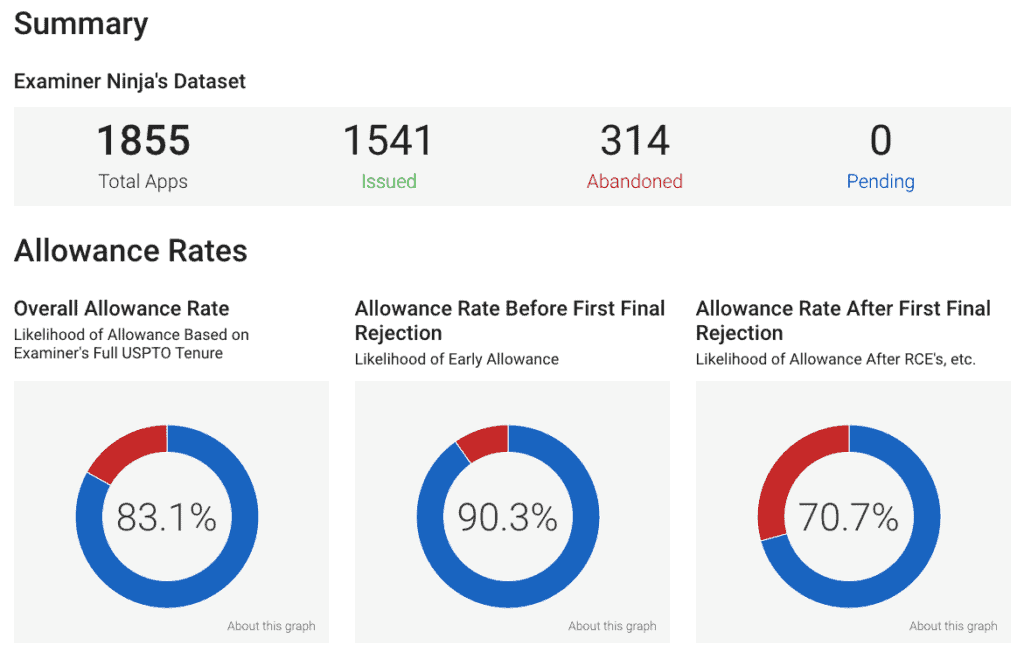

So, what this tells us is that Examiner Smith, like many other examiners, are more likely to approve something before the first final office action (early). He allows over 90% of patent applications before the first final office action.
If you have to continue the examination, it drops to 70%.
You can see how he compares to others within the Art unit 3723, and he is WAY above other examiners and seems to be FAR more lenient that others are in allowing patents through.
So, if you land examiner Smith, consider yourself lucky!
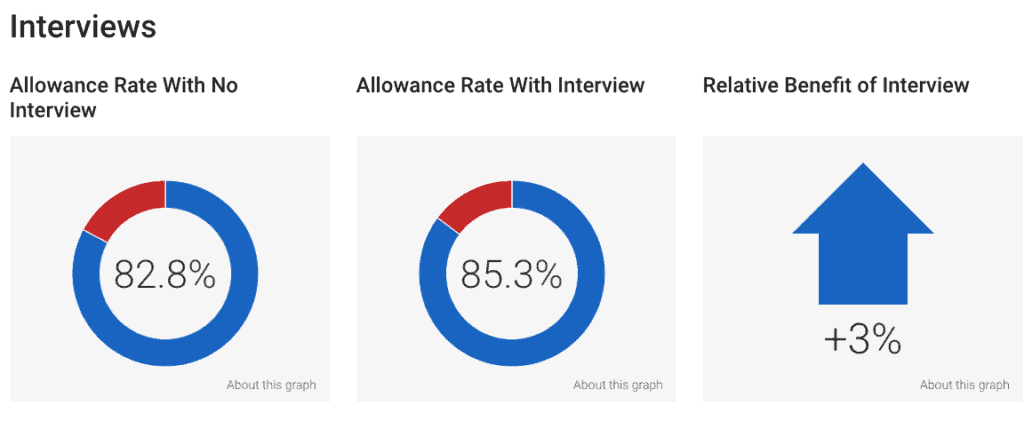
Examiner Ninja shows you the benefit of preparing and holding an interview with the examiner. This data shows that an interview is only marginally helpful. So a costly effort may not be worth it – instead it might be more efficient buckling down more time on the response.
In Conclusion: It Really Does Depend…
I know you are probably looking for an exact numerical answer on how long it takes to get a patent, but it really does depend on a case-by-case situation. However, that probably does not satisfy you…
As a VERY GENERAL rule of thumb, and as discussed above, it takes on average nearly 16 months (1 year and 4 months) to hear back from the USPTO after submittal. And over 24 months until there is a final disposition.
I encourage you to book a free consultation with us where we can talk further about the timing of getting a patent. You deserve a more personalized estimate for your specific invention. We will also provide you with our Bold Patents: The Inventor’s Guide to Patents book free of charge!
Click here to get started today!
What did you think of the article? What questions do you have about the time it takes to get a patent? Please let me know in the comments below! I am here to help!
—
Legal Note: This blog article does not constitute as legal advice. Although the article was written by a licensed USPTO patent attorney there are many factors and complexities that come into patents. We recommend you consult a lawyer if you want legal advice for your particular situation. No attorney-client or confidential relationship exists by simply reading and applying the steps stated in this blog article.


